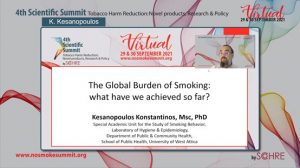At the session chaired by Dr. Karl Erik Lund and Professor Anastasia Barbouni two very interesting topics were discussed, the contribution of Tobacco Control on reducing the global burden of smoking so far, as well as existing evidence on Tobacco Harm Reduction myths and facts.
Tobacco epidemic remains a major global public health concern, started his speech Mr. Konstantinos Kesanopoulos. Presenting the effects of tobacco control policies on smoking prevalence during the last three decades, the lecturer noted that 2019 data on global prevalence of smoking show that there were 1.14 billion active smokers, almost 8 million deaths were attributable to smoking, while smoking tobacco use accounted for 20.2% of all-cause deaths among males and 5.8% among females.
Tobacco control strategies have contributed to reductions in global prevalence of smoking tobacco use of 27.5% for males and 37.7% for females, Mr. Kesanopoulos said. Between 1990 and 2019, significant decreases were observed in the prevalence of smoking tobacco use in 135 countries for males and 68 countries for females, while significant increases were observed in 20 countries for males and 12 countries for females.
Global progress in tobacco control was catalysed when the WHO FCTC passed in 2005. But despite the successes observed following its implementation, Mr. Kesanopoulos said, in several countries with large populations and high prevalence of smoking tobacco use, little to no progress has been made to reducing it; most countries did not have sufficient decreases in the prevalence of smoking to offset the demographic force of population growth, resulting in constant or increasing numbers of smokers over time; moreover, in many countries, including those that had large decreases in prevalence previously, the rate of progress has slowed, particularly in the past 5 years. To achieve the goals set forth in the SDGs (Sustainable and Development Goals 2030) and WHO global non-communicable disease monitoring framework, most countries will need stronger tobacco control policies than those already in place, Mr. Kesanopoulos pointed out.
Closing gaps in the adoption, implementation, and enforcement of evidence-based demand-reduction policies, he concluded, is vital to ending the global tobacco epidemic.
The second lecture of the session was given by Professor Giuseppe Biondi Zoccai, who presented existing evidence on tobacco harm reduction strategies. Smoking is an old but still very challenging disease―he said―and the smoking epidemic is here to stay unless we do something to prevent it and reduce the burden of this disease worldwide.
Many support strategies are available and effective, as for example, pharmacotherapy which can be useful to smoking cessation. But the main change in recent years is the concept of Modified Risk Products, Professor Zoccai said. A modified risk product (MRP) is a tobacco or tobacco-like product which can modify or hopefully reduce the global burden of disease associated with smoking, and typical MRPs are electronic vaping cigarettes (EVC) such as JUUL, and heat-not-burn cigarettes (HNBC) such as IQOS or GLO. Still, it is important to keep in mind that an MRP claim is a complex one and not synonym of a reduced risk product (RRP) claim, he explained. He added that the main dilemma we face is whether we should promote MRPs to rescue smokers using combustible cigarettes―and are unwilling or unable to quit―or we should ban or limit supporting MRPs in order to prevent addicting a whole new generation to tobacco products.
There are several pros and cons of different strategies, Professor Zoccai said, but the key problem with smokers is the will to quit and it is very difficult to motivate them to give up smoking. For better results, interventions should not be seen individually but rather as a path to smoking cessation.
Smoking represents the most impactful yet actionable risk factor for cardiopulmonary disease and cancer, Professor Zoccai concluded. E-cigs and heated tobacco cigarettes are MRPs which may improve cessation and abstinence rates from combustion cigarettes, but also create new smokers or impede eventual total cessation. Since MRPs may have substantial cardiovascular effects, he added, their use should be considered only for smoking cessation in patients at low risk, and with a specific time for eventual discontinuation.
Panel Discussion
The main problem we must deal with is to persuade people to quit smoking and to remain stable to this decision without relapsing, said Professor Ignatios Ikonomidis. Harm reduction strategies are a strong weapon that we need to learn how to use. In UK, the use of a combination of different methods such as NRT and e-cigarettes, increased smoking cessation rates, he pointed out. The use of this method results in less exposure to toxicants, less hospitalisations and less effects on public health and health economics. Of course, we need to discuss the pros and cons of this method, and more importantly, to be very careful to avoid its use by adolescents. Rules and bans need to be set, and especially, flavours that are appealing to youth to be discussed. Also―Professor Ikonomidis concluded―approved smoking cessation clinics which will use a holistic approach are needed.
The use of MRPs by adolescents is indeed a very hot topic, it is essential and should be properly addressed, Professor Barbouni commented.
In the emergency departments, Dr. Effie Polyzogopoulou said, we see many young patients presenting with coronary syndromes. These young people usually do not have other comorbidities and their only risk factor is smoking. She added that the finding presented by Mr Kesanopoulos that there are still 20 countries where prevalence of smoking continues to increase is very disappointing. We definitely have to provide alternatives to smokers, and probably smoking cessation campaigns should focus not only on the negatives of smoking but also on the positives of quitting, Dr. Polyzogopoulou suggested.
Since we face a high relapse rate in smokers who quit smoking, we need alternatives, Professor Ikonomidis said, but we have to find a balance to prevent the use of these products by adolescents. He suggested that they probably should be made unappealing for young people by increasing taxation, banning the flavours and making devices less trendy.
It is true that we have done a lot during the last 20 years, Professor Barbouni said, but we still have a long way ahead. We need to set strict rules to avoid use of alternative tobacco products by adolescents, to find a way to control the tool we have.
The dilemma is hard, Dr. Lund agreed, but we must find a way to balance the benefits for smokers with the risks for young people, while Professor Zoccai added that the solution may be to see these approaches as something not fixed.
Professor Ikonomidis noted that we should not forget that a smoker chooses to smoke because of the nicotine, while young people care more about the flavour.
It is crucial to inform adolescents about the risks of vaping, not only the absolute risks, but also about the relative ones, concluded Dr. Lund, thanking all participants and closing the session.




